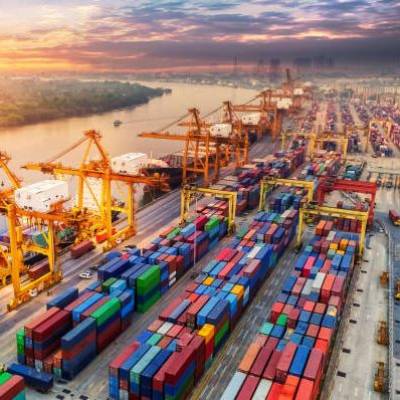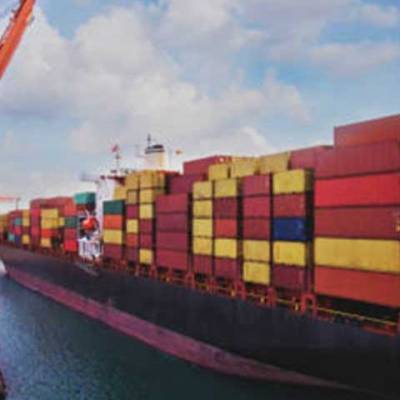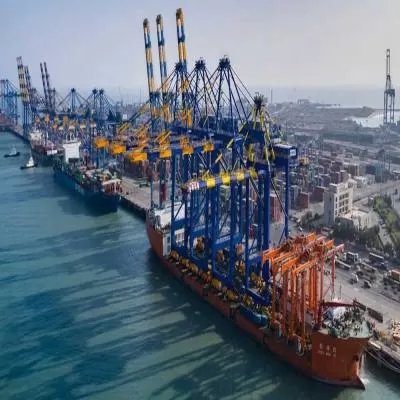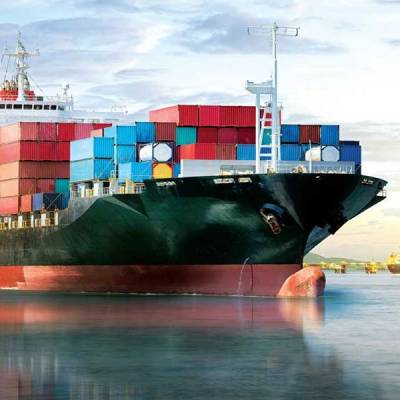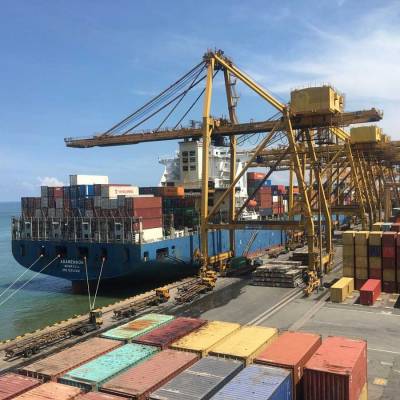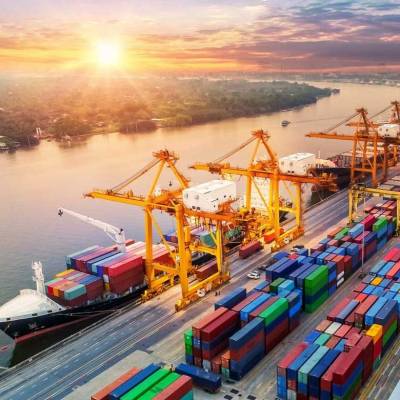- Home
- Infrastructure Transport
- PORTS & SHIPPING
- Ports - Coast Clear for Growth?

Ports - Coast Clear for Growth?
The coastline of India forms one of the biggest peninsulas in the world. India has 12 major seaports and 185 minor seaports along a coastline of over 7,000 km. The 12 major ports handle about 75 per cent of total Indian port traffic.
Needs and trends
At present, the sector needs an incentive for more competition among the major ports. Other needs include delegation of powers and responsibilities, autonomy in tariff setting and investing, fast decision-making process, operational freedom and professionalism. While the availability of natural deep water is a problem, there is room for large-scale industrial and logistic clusters.
Major ports do not or hardly compete with each other; there is a limited level of autonomy. However, owing to scarcity of port facilities, the port sector is a demand market. Huge revenue shares are offered to the Port Trusts to obtain the possibility to become operational in the port. As such, the Port Trust has limited investments to make - mostly dredging - but in return receives high revenue shares from the private sector.
In general and at least until recently, ports were ´berth minded´. This means that as soon as a port was reaching capacity, the decision was taken to construct extra berths but the performance or efficiency of the berths was not often taken into account. Fortunately, the newest major ports like the Jawaharlal Nehru Port Trust (JNPT) and Ennore serve as an example with respect to efficient cargo handling operations. JNPT, in fact, is already a world-class facility, and Ennore has the potential to become one with careful long-term planning.
Project watch Port projects approved or awarded in 2014-15 comprised Rs 7,297.35 crore; of this, Rs 6,585.72 crore was for works related to JNPT, Rs 32.55 crore for Kandla Port Trust, Rs 142.57 crore for Chennai Port Trust, Rs 103 crore for Kamarajar Port Ltd (Ennore), Rs 387.31 crore for Paradip Port Trust, Rs 8.20 crore for VO Chidambaranar Port Trust (Tuticorin), and Rs 35 crore for New Mangalore Port Trust. For ongoing projects, investments undertaken at the major ports total Rs 25,870.06 crore. Implemented PPP projects under operation in major ports include Rs 1561.35 crore for works related to Chennai Port Trust and Rs 2821.34 crore for works related to Cochin Port Trust.
With a view to promote India as an important maritime nation and attract global investments in the maritime sector, the Ministry of Shipping has decided to organise the Maritime India Summit 2016 (MIS-2016) from April 14-16, 2016.
The way ahead
All considered, going forward, here are five options for port reform:
1.Improve port organisation.
2.Liberalisation: It has worked well in JNPT. However, it is not recommended for further activities. On the contrary, in case the port wants to pursue the landlord model, the public container terminal will then be transferred to the private sector.
3.Commercialisation: Delegation of powers and responsibilities from the Ministry to the ports can achieve most benefits. The shift to the landlord port management model is a major activity to be undertaken, whereby the Port Trust will contract out non-core business; port operations will be transferred to the private sector; and the Port Trust will invest in infrastructure instead of the BOT operator in order to decrease costs for users. BOTs should be avoided when sufficient funds are available.
4.Corporatisation: This is a possible step after commercialisation. Ennore is the only corporatised major port.
5.Privatisation aspects will take place when transferring to the landlord management model through the sale of super-structural assets. Another privatisation aspect could be the formation of JVs with private-sector operators in the total transport chain to the hinterland.
Target for 2020
The Indian maritime sector needs simultaneous multiple interventions to achieve certain goals concomitant with the economic growth of the country. Here are some goals to be targeted for achievement by the end of the decade:
- Create port capacity of 3,200 mt for handling about 2,500 mt of cargo. (This would necessitate an investment of about `3 lakh crore.)
- Improve port performance to be on a par with the best in the world.
- Increase tonnage under the Indian flag as well as under Indian control. (This would need an investment of about Rs.1.20 lakh crore.)
- Increase coastal shipping and facilitate hassle-free multimodal transport.
- ncrease India´s share in global ship building to 5 per cent.
- Promote use of the inland waterways for cargo movement.
- Increase the strength of Indian seafarers to 9 per cent of the global strength by 2015 and sustain above this level.
The article has been written with data compiled from the website of the Indian Ports Association.
The Indian Ports Association examines the needs of the ports sector and what it will take for a reformation. The coastline of India forms one of the biggest peninsulas in the world. India has 12 major seaports and 185 minor seaports along a coastline of over 7,000 km. The 12 major ports handle about 75 per cent of total Indian port traffic. Needs and trends At present, the sector needs an incentive for more competition among the major ports. Other needs include delegation of powers and responsibilities, autonomy in tariff setting and investing, fast decision-making process, operational freedom and professionalism. While the availability of natural deep water is a problem, there is room for large-scale industrial and logistic clusters. Major ports do not or hardly compete with each other; there is a limited level of autonomy. However, owing to scarcity of port facilities, the port sector is a demand market. Huge revenue shares are offered to the Port Trusts to obtain the possibility to become operational in the port. As such, the Port Trust has limited investments to make - mostly dredging - but in return receives high revenue shares from the private sector. In general and at least until recently, ports were ´berth minded´. This means that as soon as a port was reaching capacity, the decision was taken to construct extra berths but the performance or efficiency of the berths was not often taken into account. Fortunately, the newest major ports like the Jawaharlal Nehru Port Trust (JNPT) and Ennore serve as an example with respect to efficient cargo handling operations. JNPT, in fact, is already a world-class facility, and Ennore has the potential to become one with careful long-term planning. Project watch Port projects approved or awarded in 2014-15 comprised Rs 7,297.35 crore; of this, Rs 6,585.72 crore was for works related to JNPT, Rs 32.55 crore for Kandla Port Trust, Rs 142.57 crore for Chennai Port Trust, Rs 103 crore for Kamarajar Port Ltd (Ennore), Rs 387.31 crore for Paradip Port Trust, Rs 8.20 crore for VO Chidambaranar Port Trust (Tuticorin), and Rs 35 crore for New Mangalore Port Trust. For ongoing projects, investments undertaken at the major ports total Rs 25,870.06 crore. Implemented PPP projects under operation in major ports include Rs 1561.35 crore for works related to Chennai Port Trust and Rs 2821.34 crore for works related to Cochin Port Trust. With a view to promote India as an important maritime nation and attract global investments in the maritime sector, the Ministry of Shipping has decided to organise the Maritime India Summit 2016 (MIS-2016) from April 14-16, 2016. The way ahead All considered, going forward, here are five options for port reform: 1.Improve port organisation. 2.Liberalisation: It has worked well in JNPT. However, it is not recommended for further activities. On the contrary, in case the port wants to pursue the landlord model, the public container terminal will then be transferred to the private sector. 3.Commercialisation: Delegation of powers and responsibilities from the Ministry to the ports can achieve most benefits. The shift to the landlord port management model is a major activity to be undertaken, whereby the Port Trust will contract out non-core business; port operations will be transferred to the private sector; and the Port Trust will invest in infrastructure instead of the BOT operator in order to decrease costs for users. BOTs should be avoided when sufficient funds are available. 4.Corporatisation: This is a possible step after commercialisation. Ennore is the only corporatised major port. 5.Privatisation aspects will take place when transferring to the landlord management model through the sale of super-structural assets. Another privatisation aspect could be the formation of JVs with private-sector operators in the total transport chain to the hinterland. Target for 2020 The Indian maritime sector needs simultaneous multiple interventions to achieve certain goals concomitant with the economic growth of the country. Here are some goals to be targeted for achievement by the end of the decade: Create port capacity of 3,200 mt for handling about 2,500 mt of cargo. (This would necessitate an investment of about `3 lakh crore.) Improve port performance to be on a par with the best in the world. Increase tonnage under the Indian flag as well as under Indian control. (This would need an investment of about Rs.1.20 lakh crore.) Increase coastal shipping and facilitate hassle-free multimodal transport. ncrease India´s share in global ship building to 5 per cent. Promote use of the inland waterways for cargo movement. Increase the strength of Indian seafarers to 9 per cent of the global strength by 2015 and sustain above this level. The article has been written with data compiled from the website of the Indian Ports Association.


